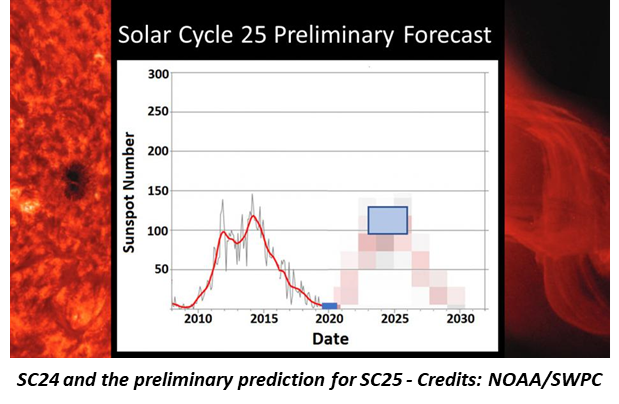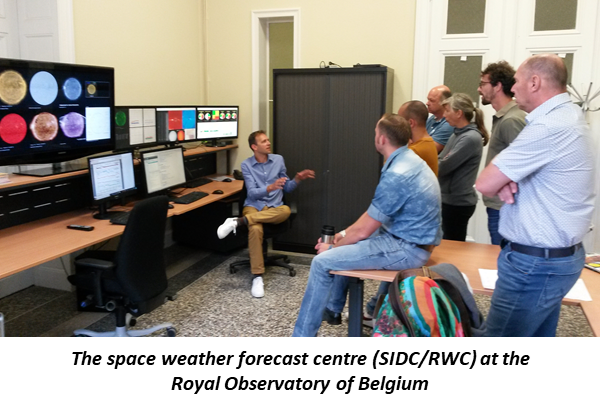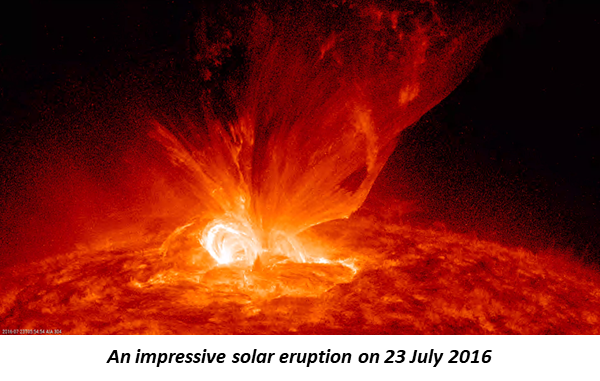The Solar Cycle 25 Prediction Panel, an international team of researchers in various solar and geophysical domains, has issued a preliminary prediction for the upcoming solar cycle 25 (SC25) based on a series of predictions that were submitted late January. Of note is that the STCE has contributed with a number of SC25 predictions (advanced sunspot statistics, polar faculae observations,...), and it had a member in the expert panel as well.
The new cycle is expected to start late in 2019 or in 2020, with solar maximum to be reached between 2023 and 2026 and the maximum (smoothed) sunspot number in the 95 to 130 range.

Thus, it seems that the strength of SC25 is going to be very similar to the still ongoing solar cycle 24 (SC24), which reached its maximum in April 2014 with a maximum smoothed sunspot number of 116.4 (SILSO), and now nearing its end. This would mean that SC25 would be again a well-below-average solar cycle, the average monthly sunspot number at solar maximum usually varying between 130 and 240 (see this STCE news item). At the same time, the prediction excludes a further decline of solar activity towards Maunder minimum like values. The Maunder minimum was a period lasting from about 1645 to 1715 when only very few sunspots were observed.
The importance of solar activity predictions several years ahead cannot be emphasized enough. Indeed, as disturbed space weather conditions can affect a wide variety of our technological systems, operators want to know well in advance if they need to take precautions. For example, a satellite operator wants to know if a soon-to-be-launched satellite is best placed in a lower or higher (costlier) orbit. Because strong solar activity affects the atmospheric drag that such satellite experiences, the solar activity determines the life expectancy of the satellite. Hence, if a strong solar cycle is predicted, operators would do well to put the satellite in a higher orbit to keep it functional as long as intended.

Though SC25 is anticipated to be a weak to moderate cycle, the panel -chaired by Lisa Upton, Ph.D. and Doug Biesecker, Ph.D.- warned that violent eruptions can occur at any time. Indeed, though no severe (X10 or stronger) solar flares and extremely severe geomagnetic storms have been observed during SC24 (see this STCE news item), satellite observations have indicated that we were just lucky. For example, on 23 July 2012 a strong, Carrington-like event occurred on the farside of the Sun, therefore having only a small effect on the earth environment. If the event had happened just 7-10 days earlier, when the source region would have been earth-facing, technological damage could have been significant. The Carrington event (1859) is still considered as the godmother of all space weather storms, inflicting worldwide damage to telegraph lines and producing bright polar lights visible as far south as Cuba!
One of the aims of the SC25 panel is also to provide for the first time a prediction of the presence, amplitude, and timing of any differences between the northern and southern hemispheres on the Sun, known as Hemispheric Asymmetry. Therefore, the panel will release an official Sunspot Number curve later this year showing the finetuned predicted number of sunspots during any given year and any expected asymmetry.
Further reading is in the press release from NOAA/SWPC and at Phys.org.






